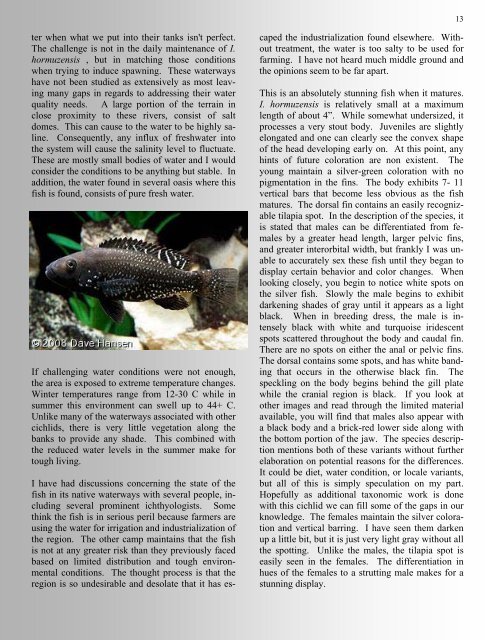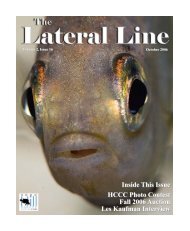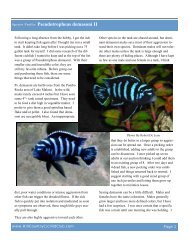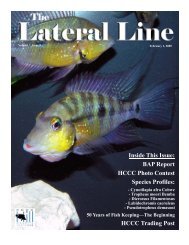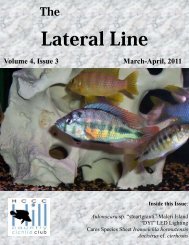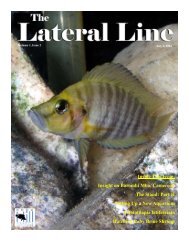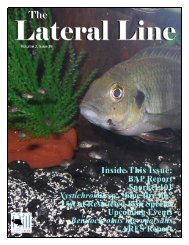December - Hill Country Cichlid Club
December - Hill Country Cichlid Club
December - Hill Country Cichlid Club
You also want an ePaper? Increase the reach of your titles
YUMPU automatically turns print PDFs into web optimized ePapers that Google loves.
13<br />
ter when what we put into their tanks isn't perfect.<br />
The challenge is not in the daily maintenance of I.<br />
hormuzensis , but in matching those conditions<br />
when trying to induce spawning. These waterways<br />
have not been studied as extensively as most leaving<br />
many gaps in regards to addressing their water<br />
quality needs. A large portion of the terrain in<br />
close proximity to these rivers, consist of salt<br />
domes. This can cause to the water to be highly saline.<br />
Consequently, any influx of freshwater into<br />
the system will cause the salinity level to fluctuate.<br />
These are mostly small bodies of water and I would<br />
consider the conditions to be anything but stable. In<br />
addition, the water found in several oasis where this<br />
fish is found, consists of pure fresh water.<br />
If challenging water conditions were not enough,<br />
the area is exposed to extreme temperature changes.<br />
Winter temperatures range from 12-30 C while in<br />
summer this environment can swell up to 44+ C.<br />
Unlike many of the waterways associated with other<br />
cichlids, there is very little vegetation along the<br />
banks to provide any shade. This combined with<br />
the reduced water levels in the summer make for<br />
tough living.<br />
I have had discussions concerning the state of the<br />
fish in its native waterways with several people, including<br />
several prominent ichthyologists. Some<br />
think the fish is in serious peril because farmers are<br />
using the water for irrigation and industrialization of<br />
the region. The other camp maintains that the fish<br />
is not at any greater risk than they previously faced<br />
based on limited distribution and tough environmental<br />
conditions. The thought process is that the<br />
region is so undesirable and desolate that it has escaped<br />
the industrialization found elsewhere. Without<br />
treatment, the water is too salty to be used for<br />
farming. I have not heard much middle ground and<br />
the opinions seem to be far apart.<br />
This is an absolutely stunning fish when it matures.<br />
I. hormuzensis is relatively small at a maximum<br />
length of about 4”. While somewhat undersized, it<br />
processes a very stout body. Juveniles are slightly<br />
elongated and one can clearly see the convex shape<br />
of the head developing early on. At this point, any<br />
hints of future coloration are non existent. The<br />
young maintain a silver-green coloration with no<br />
pigmentation in the fins. The body exhibits 7- 11<br />
vertical bars that become less obvious as the fish<br />
matures. The dorsal fin contains an easily recognizable<br />
tilapia spot. In the description of the species, it<br />
is stated that males can be differentiated from females<br />
by a greater head length, larger pelvic fins,<br />
and greater interorbital width, but frankly I was unable<br />
to accurately sex these fish until they began to<br />
display certain behavior and color changes. When<br />
looking closely, you begin to notice white spots on<br />
the silver fish. Slowly the male begins to exhibit<br />
darkening shades of gray until it appears as a light<br />
black. When in breeding dress, the male is intensely<br />
black with white and turquoise iridescent<br />
spots scattered throughout the body and caudal fin.<br />
There are no spots on either the anal or pelvic fins.<br />
The dorsal contains some spots, and has white banding<br />
that occurs in the otherwise black fin. The<br />
speckling on the body begins behind the gill plate<br />
while the cranial region is black. If you look at<br />
other images and read through the limited material<br />
available, you will find that males also appear with<br />
a black body and a brick-red lower side along with<br />
the bottom portion of the jaw. The species description<br />
mentions both of these variants without further<br />
elaboration on potential reasons for the differences.<br />
It could be diet, water condition, or locale variants,<br />
but all of this is simply speculation on my part.<br />
Hopefully as additional taxonomic work is done<br />
with this cichlid we can fill some of the gaps in our<br />
knowledge. The females maintain the silver coloration<br />
and vertical barring. I have seen them darken<br />
up a little bit, but it is just very light gray without all<br />
the spotting. Unlike the males, the tilapia spot is<br />
easily seen in the females. The differentiation in<br />
hues of the females to a strutting male makes for a<br />
stunning display.


